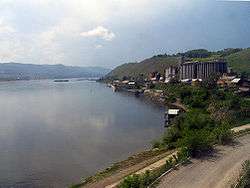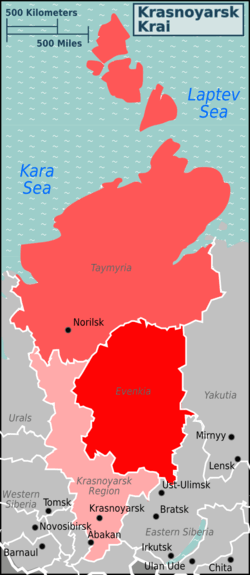Krasnoyarsk Krai
Krasnoyarsk Krai (Красноя́рский край) is a vast, sparsely populated region in Siberia about three and a half times the size of Texas, comprising 13% of Russia's territory.
Other destinations
- 🌍 Severnaya Zemlya — the last archipelago in the world to be discovered, Severnaya Zemlya is of interest to ecotourists and those wishing to get away from it all in the most dramatic possible way
Understand
Krasnoyarsk Krai is located in the remote geographical center of Russia along the great Siberian river, the Yenisey (the world's fifth largest by length and volume), and its tributaries. West of the Yenisey, Krasnoyarsk Krai begins the unending flat sea of taiga and tundra that ends with the Ural Mountains, while the majority of the Krai (to the east of the Yenisey) is covered by the beautiful mountainous wild of the Sayan Mountain Range and the Putoran Plateau. For the truly adventurous, wilderness travel in this region is limited only by safety concerns and imagination, as the Soviet government deliberately kept most of Krasnoyarsk Krai closed and devoid of human presence.
The southern Krasnoyarsk region is the heart of this vast area and its most visited region as it contains the city of Krasnoyarsk, the third largest in Siberia and is a major stop on the Trans-Siberian Railway.
The remote Yenisei Basin served at the place of exile for a number of people throughout the centuries. During the Czarist era, Lenin spent a few years (1897-1900) in exile in Shushenskoye, one of the warmest place in the region; a few years later, Stalin served his term of exile in considerably colder Turukhansk. In the 1930s through the 1950s, numerous camps of the GULAG system were located in the region.
The post-WWII era saw rapid industrial development of the region. Two giant hydro dams (Krasnoyarsk and Sayano-Shushenkaya) were constructed on the Yenisey and coal strip mines opened along the Trans-Siberian line, their power used at aluminum refineries and at a number of military industrial facilities.

Сlimate
The climate is strongly continental with wide variation of temperatures during the year. The climatic belts are three: arctic, subarctic and moderate. The average temperature of January in the north is −36 °C and −18 °C in the south. In July the temperatures are +10 °C and +20 °C accordingly.
Talk
These days, virtually everyone in the region speaks Russian, either natively or as a second language.
There are a number of indigenous languages spoken throughout the region, such as Evenki and Nenets, but travelers are unlikely to hear them unless they specifically seek them out. The Ket language, of which there are hardly 200 speakers left, is the only still surviving (barely) language of the Yeniseyan language family, which some linguists think may be related to the Na-Dené languages of northwestern North America (which include Apache and Navajo).
Get in
The usual manner in which travelers arrive to Krasnoyarsk Krai is undoubtedly at the Krasnoyarsk stop on the Trans-Siberian Railway. If you are planning a trip specifically to the region, however, it will save a lot of time to fly directly to Krasnoyarsk airport (from Moscow, Saint Petersburg, Khabarovsk, Rostov-on-the-Don, or virtually any airport in Siberia) and then transfer to Kras-Air to go to other destinations within the region.
For visitors to the northern parts of the region, there is a direct flight from Moscow to Khatanga and Norilsk (although this airport may be off limits to foreigners) in Taymyria as well as to Igarka in the northernmost part of Krasnoyarsk (region).
Get around
Because of the size and remoteness of the region, domestic flights combined with helicopter rides are often the best ways of getting around outside of the more populous southern region. Flights are most often connected to the Krasnoyarsk hub. To get straight into Evenkia, there is a flight from Krasnoyarsk to Tura.
See

- Big Arctic Reserve
- Sayano-shushensky Biosphere Reserve
- Putorano Plateau Nature Reserve (UNESCO Heritage)
- Stolby Reserve
- Taimyr Reserve
- Tungusska Reserve
- Central Siberian Reserve
- National Park "Shushensky Bor"
- Nature Park "Yergaki"
Do
- Sayan Ring (Саянское кольцо) - international festival of ethnic music in Shushenskoye
Eat
Drink
Stay safe
Heroin trade is extensive in the region and HIV infections are high as a result.
Go next
It will likely take a while to get out from any destination in the north. From Krasnoyarsk, however, Irkutsk is the next major stop on the Trans-Siberian Railway to the east after Kansk; to the west after Achinsk are Tomsk (on a branch line) and Novosibirsk. Bratsk is also reachable to the east via the Baikal-Amur Mainline.
